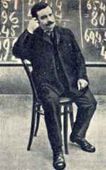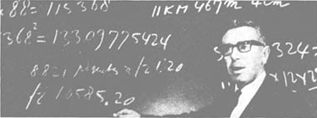 Individuals with preternatural abilities to calculate arithmetic results without pen, paper or other instruments, and to do so at astonishing speed, are the stuff of mathematical and psychological lore. These “lightning calculators” were sometimes of limited mental ability, sometimes illiterate but of average intelligence, and sometimes exceptionally bright, this despite the popular notion of the idiot savant. The techniques used by these people are not generally well known. In fact, despite claims by educators that acquiring a mental facility with arithmetic operations is essential to a student’s mathematics education, I see little in the textbooks other than simple estimations based on rounding values, surely the most basic and least interesting mental task. The field of mental calculation may not be a lost art per se, but in this digital age it most certainly is a neglected one.
Individuals with preternatural abilities to calculate arithmetic results without pen, paper or other instruments, and to do so at astonishing speed, are the stuff of mathematical and psychological lore. These “lightning calculators” were sometimes of limited mental ability, sometimes illiterate but of average intelligence, and sometimes exceptionally bright, this despite the popular notion of the idiot savant. The techniques used by these people are not generally well known. In fact, despite claims by educators that acquiring a mental facility with arithmetic operations is essential to a student’s mathematics education, I see little in the textbooks other than simple estimations based on rounding values, surely the most basic and least interesting mental task. The field of mental calculation may not be a lost art per se, but in this digital age it most certainly is a neglected one.
Part I of this essay attempts to take a fresh look at both historical and modern lightning calculators. Part II describes classic and modern methods of mental calculation. And finally, Part III demonstrates as a cautionary tale the shallow and deceptive nature of most media coverage of lightning calculators, an important consideration in analyzing reports on them.
The subject of lightning calculation has been an interest of mine for many years. Although I’m certainly not a lightning calculator, as a graduate teaching assistant in physics in the early 80’s I enjoyed mentally calculating the results of problems to quite high accuracy while the students were working their calculators, and I would typically end the semester with a class on such methods. In 1988 I started gathering material for a book on methods of high-precision mental calculation of arithmetic as well as elementary functions such as logarithms, exponentials and trigonometric functions (Dead Reckoning: Calculating Without Instruments, 1993). A few years ago I started my main website MyReckonings.com mainly to devote a portion of it to notes and errata for the book, as well as serve as a repository for papers I’ve written on topics of mental calculation. The website area devoted to the book can be found here and the page devoted to additional papers is found here, where some of the links in this essay are directed.
The history of lightning calculators, at least to 1983, is presented most comprehensively in Steven B. Smith’s book, The Great Mental Calculators: The Psychology, Methods and Lives of Calculating Prodigies Past and Present. This is a fascinating read and an honest attempt to analyze the capabilities and methods of a number of these individuals. Smith notes that isolation (at least mental isolation), generally in children, is a condition favoring the development of this ability, and it’s hard to argue with that. He describes a gamut of lightning calculators who run the spectrum of mental acuity.
So let’s see who we have in the book. Grouping people by their overall mental acuity is a dangerous sport prone to misinterpretation and error (for example, it is impossible for me to classify Thomas Fuller (1710-1790) because he was a victim of the slave trade in America). As a rough interpretation by me from Smith’s book, among those that seem to be of low intelligence (which represents a large range) are

- Jedidiah Buxton (1702-1792) — far right figure (a portrait drawing)
- Henri Mondeux (1826-1861)
- Jacques Inaudi (1867-1950) — near right figure seated
Among those who seem of average intelligence are
- Zerah Colburn (1804-1839)
- Johann Martin Zacharias Dase (1824-1861)
- Pericles Diamandi (1868- )

- Arthur Griffith (1880-1911)
- Salo Finkelstein (1896/7-?)
- Maurice Dagbert (1913-?) — bottom left figure with hands to his temples
Those who seem to have exceptional intelligence include
- George Parker Bidder (1806-1878)
- Truman Henry Safford (1836-1901) — as a boy in right figure
- Frank D. Mitchell
- Gottfried Ruckle (1879-1929)

- Wim Klein (1912-1986) — right figure and lowest right figure, both at chalkboards
- Hans Eberstark (1929- )
- Shyam Marathe (1931- )
- Shakuntala Devi (1932- )
- Arthur Benjamin (1961-)
And those with ability in this area who left a permanent mark on mathematics and science certainly include
- Alexander Craig Aitken (1895-1967) — lower right figure, in profile
- John Wallis (1616-1703 )
- Andrè Ampere (1775-1836)
- Leonhard Euler (1707-1783)
- Karl Frederich Gauss (1777-1855)
- John von Neumann (1903-1957)
 So in fact we see a predominance of ability in those with higher mental acuity, and it turns out that as we proceed to later names here we find that these abilities remained or were developed in adulthood. Savants are certainly more fascinating because of their lack of ability in other areas, but the talents of those without disabilities is certainly in contrast to the popular conception of lightning calculators.
So in fact we see a predominance of ability in those with higher mental acuity, and it turns out that as we proceed to later names here we find that these abilities remained or were developed in adulthood. Savants are certainly more fascinating because of their lack of ability in other areas, but the talents of those without disabilities is certainly in contrast to the popular conception of lightning calculators.
Watch a child who is doing math homework—when they are calculating the answer they generally get quite physically agitated, tapping a pencil, shaking or hitting their heads, standing up and sitting down, talking, etc. It’s quite striking when you are looking for it, a strange association between mathematical reasoning and motor functions that makes you wonder if the standard, ultra-quiet testing environment in school is really ideal. Some (probably most) lightning calculators such as Inaudi, Colburn, Safford, and Benjamin, were or are quite agitated while performing.  These are termed auditory calculators, but there are visual calculators as well (Diamondi, who had a “photographic” memory, Ruckle, Marathe, Dase, etc.) and those who don’t fit neatly into either category (Klein, Aitken). There are also those who experience synaesthesia, seeing colors when hearing or visualizing numbers (such as Daniel Tammet, who also visualizes “landscapes” and “spirals” of numbers. Smith even describes a “tactile” calculator.
These are termed auditory calculators, but there are visual calculators as well (Diamondi, who had a “photographic” memory, Ruckle, Marathe, Dase, etc.) and those who don’t fit neatly into either category (Klein, Aitken). There are also those who experience synaesthesia, seeing colors when hearing or visualizing numbers (such as Daniel Tammet, who also visualizes “landscapes” and “spirals” of numbers. Smith even describes a “tactile” calculator.
 Another topic of great interest and historical misunderstanding concerns the calculation process itself. It is often assumed that the results are spontaneously produced by an unconscious, mysterious and instantaneous process. Smith concludes that this is false, that the calculation proceeds through a sequence of operations that is conscious or semi-automatic, much like spoken language or touch typing. The brain scan figures that are shown later, in fact, show in red the areas of the brain used by the modern lightning calculator Rüdiger Gamm (in green and red) compared to several non-expert calculators (in green) as described in a paper here.
Another topic of great interest and historical misunderstanding concerns the calculation process itself. It is often assumed that the results are spontaneously produced by an unconscious, mysterious and instantaneous process. Smith concludes that this is false, that the calculation proceeds through a sequence of operations that is conscious or semi-automatic, much like spoken language or touch typing. The brain scan figures that are shown later, in fact, show in red the areas of the brain used by the modern lightning calculator Rüdiger Gamm (in green and red) compared to several non-expert calculators (in green) as described in a paper here.
So how fast were/are these lightning calculators? The short answer is that the reported times, those that have any validity at all, are all over the map. Often those who report on times did not recognize attributes of specific problems that led to easy solution, or based their reports on second-hand or promotional material, or ignored delay tactics such as writing down or repeating the problem. Often the reports don’t indicate when timing began and stopped, and it often goes unreported whether the problem was in sight during the calculation and whether the answer was produced digit-by-digit or as a complete solution. Some times are considered beyond credibility or markedly inconsistent with the difficulties of various questions.
Smith attempts to sort through the available data on historical calculators, a seemingly frustrating enterprise. A decent set of tests were conducted by the noted psychologist Alfred Binet in 1894 and there was so much confusion on the best way to measure response times that a device that traced respiration on a revolving cylinder was settled on, but even Binet didn’t record whether the answers were written down or if the first or last digit of the answer was the initial trigger. Inaudi took an average of 2.0 seconds for 2-digit by 2-digit (2×2) multiplications, 6.4 seconds for 3×3 multiplications, 21.0 seconds for a 4×4 multiplication, and 40.0 seconds for a 6×6 multiplication. Diamandi did much worse but the problem was removed from view during the test and timing was definitely stopped after the last digit was written, so it is not a fair comparison. Ruckle and Finkelstein did worse than Inaudi in later identical tests. Klein was demonstrably fast, but in tests in 1953 he was allowed to view the problem and write down digits as he obtained them, a definite advantage for someone like him who used cross-multiplication. Nonetheless his time of 48 seconds to multiply two 9-digit numbers and 65-2/3 seconds to multiply two 10-digit numbers is very impressive. Klein also extracted integer roots of numbers, particularly 13th roots of 100-digit numbers, achieving a 1 min 28.8 sec time at one point.
As for the size of problems, Dase reportedly multiplied two 8×8 digit multiplications in 54 sec, a 20×20 digit multiplication in 6 min, a 40×40 digit multiplication in 40 min, and a 100×100 digit multiplication in 8 ¾ hours. Gauss later posed the question of who checked that last answer (adding that it was “a crazy waste of time”), and in fact lightning calculators often made errors, but of course those aren’t typically reported. Buxton, who could not read or write numbers, squared 725,958,238,096,074,907,868,531,656,993,638,851,106 in his head over the course of 2-1/2 months, an astonishing feat of concentration that is scarcely marred by an error of one digit in the answer (this was an attempt to square 2139 but based on a flawed value for 2138). Alexander Craig Aitken extracted non-integer roots among other calculations, merging his natural speed in arithmetic with mathematical approximation and iteration formulas. And John Wallis before him extracted the square root of 3×1040 to 21 digits during one sleepless night and of a 55-digit number to 27 places during another night. Dase is also reported to have extracted square roots of perfect squares of 100 digits and 60 digits, but with no times given.
The biographical details of these lightning calculators make interesting reading but are not the focus of this essay. There are a number of sites that provide the history of their lives or links to them, such as those listed found here, here, here, here, here, here, here, and especially Oleg Stepanov’s site that contains many historical articles on various mental calculators here.
There are modern-day lightning calculators, of course. Some of those listed above who have a good amount of history in this field (such as Arthur Benjamin and Shakuntala Devi) still perform in public. There are also relative newcomers that I am aware of through the Yahoo Mental Calculation Group, such as Rüdiger Gamm, Gert Mittring, Alexis Lemaire, Robert Fountain, George Lane, John van Koningsveld, Alberto Coto, Willem Bouman, Andy Robertshaw, Matthias Kesselschläger, Yusnier Viera Romero and Jorge Arturo Mendoza Huertas, but this is a highly Eurocentric view (other than the last two) because of the makeup of the Yahoo group and the participants in the Mental Calculation World Cup held in Europe. Unfortunately, I’m not familiar with the many other newer lightning calculators from around the world—Chan Hee Yi of Korea has been pointed out, and India certainly has a number of such talented individuals. (I nearly decided not to list any modern calculators to avoid slighting other people who certainly deserve to be listed—rest assured that all omissions are due to my limited knowledge in this area.)
Below are some links to good videos on lightning calculators in various languages:
- Wim Klein and Hans Eberstark at CERN (where Klein worked) from 1973 is found here.
- Wim Klein at CERN in 1959 is found here.
- A two-part documentary on Rüdiger Gamm can be found here and here.
- Videos of Arthur Benjamin are found here and here.
- A lecture by Gert Mittring on extracting cube roots is here.
- A video on Jan van Koningsveld is found here.
- A Dutch TV program on Willem Bouman is found here.
The history of lightning calculators is interesting from a human standpoint, but it’s perhaps more intriguing because the methods they learned or developed are uniquely suited for fast mental calculation. These methods are different from the ones taught in school for pencil-and-paper solution, and therefore most people are quite surprised when they find out that other algorithms such as these exist. Techniques designed specifically for mental calculation are the subject of the second part of this essay.
>>> Go to Part II of this essay
Printer-friendly PDF of Lightning Calculators Parts I-III.